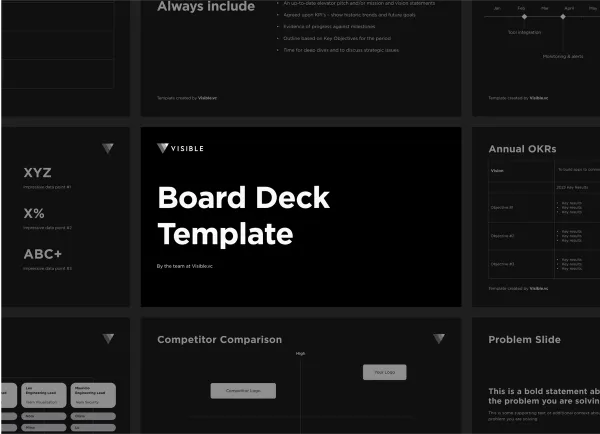
Startup founders are pulled in a hundred different directions on any given day. On top of building a product, hiring a team, fundraising, selling, and more, founders are responsible for managing relationships with investors and board members.
Why is a Board Deck Important?
Oftentimes, preparing for a board meeting can get buried in the list of to-dos. However, when leveraged correctly, your board members and meetings can be a high-leverage activity for success.
As Matt Blumberg, CEO of Bolster, puts it, “Leading a world-class board is one of the single most important things startup CEOs can do to help their businesses thrive and become industry leaders.”
To help you prepare for your next board meeting, we’ve put together a list of resources and tips to help you build and share your board deck. Learn more below.

Related Resource: Our Downloadable Board Deck Template
What Should You Include in Your Board Deck?
The goal of a board of directors can be boiled down to helping a company achieve its goals. While there are certainly more areas, a board, especially for startups, is fit to help in a few key areas:
- Hiring and recruiting employees
- Provide direction and strategy for the company
- Represent other investors and members of the business
- Build a governance system
- Maintain relationships with CEO and executives
To make sure that you are getting the most out of your board of directors, coming to your board meetings prepared is vital. One of the key aspects to help you guide your meeting and highlight key talking points is having a well-thought-out board deck.
Learn more about what should be included in your board deck below:
1) A High-Level Update From the Founder
To kick off any board meeting or board deck, there should be a quick high-level overview from the founder and/or CEO. The purpose of this is to set the tone for what is to come and a general overview of how the past period (month, quarter, etc.) went for the business. Be sure to share any big wins from the previous period or quickly hit on things that might be negatively impacting you and your company.
Think of this as the “big picture” for both the previous period and the company as a whole. Using the sections below, you can use the high-level update as a time to quickly hit on each of those to set expectations for what is to come throughout the meeting.
Related Resource: Crafting the Perfect SaaS Board Deck: Templates, Guidelines, and Best Practices
2) A Section on KPIs and Metrics
Next, dig into the KPIs and metrics from the previous period. The purpose of this is to give everyone the proper data and context they need to understand decisions that will be made later in the meeting. These metrics and KPIs should be agreed upon beforehand and everyone in the room should understand what they mean and how they impact the business.

It is important to keep these metrics consistent from meeting to meeting. This helps everyone focus on what truly matters and will build trust with investors. It is worth noting that this could include qualitative metrics as well — customer stories or quotes are always great to share!
3) An Update on the Team and Organization as a Whole
After digging into your KPIs and metrics, spend some time on your org chart and hiring plans. One of the places boards are best suited to help with is hiring and finding key talent so making sure you make the most of this section is vital.
We recommend starting with a current org chart so investors and board members can understand where your headcount lies. From here, we recommend hitting on what teams need additional talent and walking through the roles you are hiring for. Be prescriptive as possible so they can reach out to their networks and find candidates for your company.
4) Product Development Update
At this point, you’ve likely hit on the organization as a whole and how the business is performing as a whole. Next, you will want to dig into the product development and status of any new features or products you’ve released or been working on since your last meeting.
This can be a time to provide additional metrics or share stories of how a new feature might be impacting your business. This can be used to further working/strategy sessions towards the end of the meeting.
5) An In-Depth Section on Organizational Strategy and Product Strategy
Towards the end of your meeting is the true “meat and potatoes” of your meeting. This is a strategy or working session that should give you concrete steps and plans to take away from the meeting. It is generally recommended that this section should take 50%+ of your meeting time.
This section can cover just about any issues you are facing as a founder (keeping in mind what your board members are best suited to help with). For example, if you are facing hiring challenges, highlight those and discuss what you want your org chart to look like. You can use it to plan a fundraising or financial event in the coming months. Or you can use this as a time to build a higher-level product roadmap.
No matter what you use this for, make sure you have your talking points prepared so you can make the most of this section.
6) A Miscellaneous Chapter
As always, save some time for miscellaneous or other topics. This can be official board business or governance. This might cover things like board resolutions, appointments, stock options, and more.
Related Resource: What We’ve Learned From Investors About Running a Board Meeting
Tips for Creating a Board Deck
While there is no one-size-fits-all template to help you knock out your next board meeting deck, there are resources and best practices that you can use for your next meeting.
Use a Template
As we mentioned earlier, there are ~6 key areas you will likely want to hit on throughout a board meeting. Of course, the specifics and structure will vary from business to business.
To help you select what is most important to your business, we’ve put together a board deck template. This template aims to help you structure the meeting and build your agenda.
Give the board deck template a try here:
Keep Slides Simple
The goal of a board meeting is to prompt conversation. To do this, it is important to make sure your slides are simple and easily digestible. Make sure your slides are not full of unnecessary words and context. Use bullets and your narrative to help board members with any additional context they might need.
Share Deck Materials Early
To have the best conversation possible at your board meeting, you need to make sure everyone on your board is well prepared. To do so, make sure you are sending your board materials in advance so they can have an understanding of the past period and will be able to dig into tactical questions.
As we wrote in our post, How to Get the Most Out of Your Next Board Meeting, “Most founders/CEO have found it best to send over their pre-meeting report/packet at least 4 days in advance.”
Depending on your meeting cadence, you will want to send over things like your agenda, important matters, metrics, and more before your next board meeting to set the stage. Check out an example of what to send below:
Related Resource: Pre-Board Meeting Update Template
Use Visuals
Ultimately, the content of your deck is what matters most, but having polished visuals certainly does not hurt. We suggest using concise and repeatable visuals in your board decks.
For example, if you include a certain chart style/format, try to keep it consistent from deck to deck. There are also opportunities to improve your board with simple visuals and charts to help your board members visualize your company's status.

Common Mistakes to Avoid When Creating a Board Deck
Finding the right board deck format and style will likely take a few reps. As you sit through more board meetings, you should hear feedback and suggestions to help improve the actual format and content of your board decks. However, there are some common mistakes you can avoid from the get-go — check them out below:
Not Having a Deep Understanding of Your Audience
Board members want to see that you have an understanding of your audience — both themselves as stakeholders and your customers. Make sure that you are hyperfocused on your key stakeholders. This will help board members build conviction and trust in how you operate your business.
Not Having a Clear Objective
What do you want your board to accomplish after reading your deck? Do you want them to make a decision? Approve a new project? Provide feedback? Once you know your objective, you can structure your deck accordingly.
Overloading the Deck With Information
Your board deck should be concise and to the point. Avoid including too much information, as this can overwhelm your board and make it difficult for them to focus on the most important points. Too much information can also lead to questions and concerns about unrelated points/problems that you are trying to solve.
Using Too Much Industry Jargon or Technical Language
While your board should be familiar with your business, they are likely helping many other companies. To make sure everyone is on the same page, make sure to avoid technical language — it may seem obvious to see but is not always the case for someone not involved in the day-to-day.
Start Your Funding Journey With Visible

Running a successful board meeting can be a high-leverage activity for your startup. The easiest thing you can do is come prepared and ready to have a strategic conversation with the people who matter most to your business.
Let us help prepare for your next board meeting or fundraising event. Raise capital, update investors and engage your team from a single platform. Try Visible free for 14 days.




